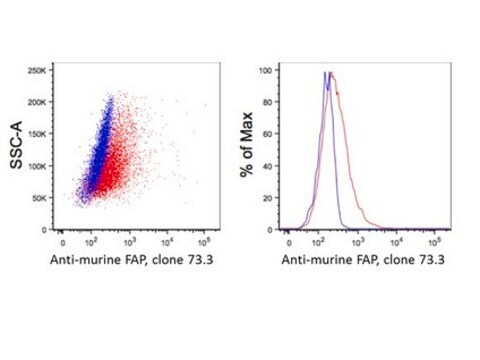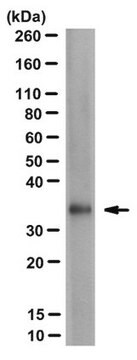MABN784
Anti-FMR1polyG Antibody, clone 2J7
clone 2J7, from mouse
Sinonimo/i:
Fragile X mental retardation protein 1 RANT fusion, FMR1polyG, FMRP RANT fusion, FMR-1 RANT fusion
About This Item
Prodotti consigliati
Origine biologica
mouse
Forma dell’anticorpo
purified immunoglobulin
Tipo di anticorpo
primary antibodies
Clone
2J7, monoclonal
Reattività contro le specie
human
tecniche
immunocytochemistry: suitable
immunohistochemistry: suitable
western blot: suitable
Isotipo
IgG2bκ
N° accesso UniProt
Condizioni di spedizione
wet ice
modifica post-traduzionali bersaglio
unmodified
Informazioni sul gene
human ... FRAXA(2477) , FRAXA(108684022)
Descrizione generale
Specificità
Immunogeno
Applicazioni
Immunohistochemistry Analysis: A representative lot detected both ubiquitinated inclusions-associated and non-inclusions-associated FMR1polyG immunoreactivity by dual fluorescent immunohistochemistry using paraffin-embedded brain tissue sections from Fragile X-associated Tremor/Ataxia syndrome (FXTAS) patients (Todd, P.K., et al. (2013). Neuron. 78(3):440-455).
Western Blotting Analysis: A representative lot detected recombinant FMRpolyG GST fusion constructs, while only one immunoreactive band (~15 kDa) could be detected in Fragile X-associated Tremor/Ataxia syndrome (FXTAS) patients brain lysates due to extended aggregation of FMR1polyG (Todd, P.K., et al. (2013). Neuron. 78(3):440-455).
Immunocytochemistry Analysis: A representative lot detected exogenously expressed FLAG-FMR1polyG constructs by fluorescent immunocytochemistry (Todd, P.K., et al. (2013). Neuron. 78(3):440-455).
Neuroscience
Neurodegenerative Diseases
Qualità
Western Blotting Analysis: 1.0 µg/mL of this antibody detected an exogenously expressed FMR1polyG GFP fusion construct in transfected COS cells.
Descrizione del bersaglio
Stato fisico
Stoccaggio e stabilità
Altre note
Esclusione di responsabilità
Non trovi il prodotto giusto?
Prova il nostro Motore di ricerca dei prodotti.
Raccomandato
Codice della classe di stoccaggio
12 - Non Combustible Liquids
Classe di pericolosità dell'acqua (WGK)
WGK 1
Punto d’infiammabilità (°F)
Not applicable
Punto d’infiammabilità (°C)
Not applicable
Certificati d'analisi (COA)
Cerca il Certificati d'analisi (COA) digitando il numero di lotto/batch corrispondente. I numeri di lotto o di batch sono stampati sull'etichetta dei prodotti dopo la parola ‘Lotto’ o ‘Batch’.
Possiedi già questo prodotto?
I documenti relativi ai prodotti acquistati recentemente sono disponibili nell’Archivio dei documenti.
Il team dei nostri ricercatori vanta grande esperienza in tutte le aree della ricerca quali Life Science, scienza dei materiali, sintesi chimica, cromatografia, discipline analitiche, ecc..
Contatta l'Assistenza Tecnica.





